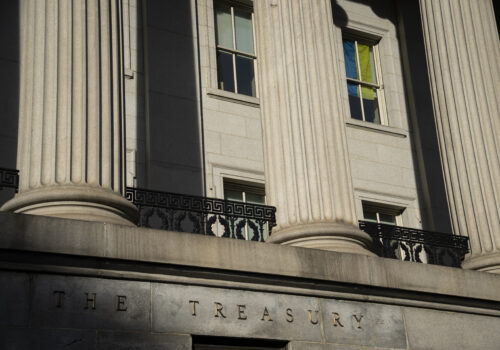Without development finance, the United States can’t deliver on strategic investment
During the 2025 Annual Meetings of the World Bank Group and the International Monetary Fund (IMF), many of the speakers emphasized the decline in financing for development. Dismantling the United States Agency for International Development (USAID) was the biggest hit in 2025, but official development assistance (ODA) has been shrinking since 2023. In the last two years, eleven member countries of the Development Assistance Committee have publicly announced budget cuts to their development aid programs.
The chart below shows an estimate of how much ODA could be lost from the 2023 baseline, if Group of Seven (G7) countries go through with their promised funding cuts.
Major providers of ODA have announced cuts to aid spending for 2025 and beyond. 2024 marked the first time that the United States, the United Kingdom (UK), France, and Germany have all cut aid at the same time in nearly thirty years. As a result, the Organization for Economic Co-operation and Development estimates that ODA decreased by 9 percent in 2024 and could fall by as much as 17 percent in 2025.
Meanwhile, the current US administration has endorsed an approach to development investment that is more geopolitical and transactional. To achieve its strategic goals, the United States should seek to reform or empower domestic development finance institutions (DFIs), instead of abandoning the framework entirely. Washington has existing development agencies and expertise that have helped to deliver economic gains globally and would lend themselves to facilitating and implementing new investment. Specifically, blended finance is instrumental in fulfilling bilateral deals to secure critical supply chains or promote US industry abroad.
Funding cuts aren’t the only trend affecting development finance
Pulling back funding from traditional donors has been the main driver of recent declines in ODA. With growth slowing down and shrinking fiscal spaces, donor countries are reprioritizing their spending priorities. Across the board, there have been reductions in contributions to international organizations, lower levels of humanitarian aid, and reduced spending on hosting refugees in donor countries.
For example, the chart above captures the changes in a few key countries. The United States dismantled USAID in January, cutting billions of dollars of global aid overnight. France and Germany have also decreased aid budgets and placed a series of existing programs under review. In the UK, Prime Minister Keir Starmer intends to decrease the foreign aid budget from the current rate of 0.5 percent of gross national income to 0.3 percent by 2027, citing the need to increase defense spending.
In October, the Atlantic Council hosted the president of the European Investment Bank (EIB), Nadia Calvino, and she reiterated the EIB’s commitment to financing climate transition, furthering gender equality, and assisting with Europe’s defense build-up. While she shared the important continuities in the EIB’s mission, she also highlighted that the development finance landscape has been changing for years now.
Retrenchment from traditional donors is just one trend in the evolution of global development policy. The DFIs have been adapting to fewer large-scale infrastructure loans, increased involvement from the private sector, and the emergence of “middle-power” lenders—namely China. In recent years, traditional lenders have also prioritized geopolitical interests when making decisions about development finance.
Geopolitical interests shouldn’t supersede effective development principles
Major ODA providers have increasingly started to look at development finance through the lens of strategic competition and move from aid to investment. The proliferation of China’s Belt and Road Initiative helped to spur political will in the United States and G7 allies for the Global Gateway Initiative and the Partnership for Global Infrastructure and Investment (PGII). BRICS countries have created their own new development finance institutions, such as the New Development Bank. At the Atlantic Council GeoEconomics Center, our experts wrote about a framework for positive economic statecraft in 2023 and have continued to work on how this could be operationalized to meld development goals with national security.
However, the current US administration has leaned away from the principles of effective development aid. Its “America First” policy reframes foreign assistance as more transactional, focusing on trade and bilateral investments and taking a step back from issues such as climate transition and poverty reduction. The US-Ukraine Reconstruction Investment Fund, commonly referred to as the US-Ukraine critical minerals deal, is reminiscent of the resource-for-infrastructure deals that China popularized in Africa, which received extreme criticism for their extractive nature. The $40 billion in support for Argentina marks an unprecedented, unilateral move by the United States. When the IMF provides bailouts, the programs include certain stipulations for improving economic stability. US support to Argentina seems to, instead, be contingent on President Javier Milei’s party staying in power. These US policies should prompt a reckoning from other actors about how geopolitics can or should fit into the development sphere.
Donor countries benefit from continuing effective development assistance. More stable economic environments globally facilitate sustainable investment deals in infrastructure and more. G7 initiatives, such as the Global Gateway or PGII, can’t compete with China in terms of lending volume, but they offer a value proposition of rigorous impact evaluation and development best practices to help countries avoid debt traps and maintain long-term financing. In the October editions of the World Economic Outlook and the Global Financial Stability Report, issues such as climate change or gender equality were barely mentioned, but these remain important considerations to achieve sustainable and equitable global development.
The United States should seek to meld strategic investment objectives with long-term development goals to achieve sustainable changes in the global economy. Blended finance represents an entry point for the administration to leverage existing agencies to achieve strategic goals.
Blended finance can be leveraged to deliver on strategic investment promises
Public-private partnerships—or blended finance—have become a popular area of interest for delivering critical public infrastructure. The World Bank estimates that the infrastructure funding gap is around $1.5 trillion annually, and the use of private capital is crucial to address this gap so that countries can optimize already scarce public funds.
Blended finance helps to crowd private capital into development projects by mitigating investment risk. This strategy is not without its pitfalls. But given the immense development financing need and shrinking ODA, blended finance is a critical tool for creating funding opportunities. DFIs can help coordinate investment instruments and mechanisms, such as risk guarantees, project insurance, syndicated loans, or equity instruments, which have proven especially useful in emerging technologies and when promoting first movers. In the past, the United States and G7 allies have successfully leveraged public-private partnerships to compete with Chinese lending and to further both strategic and development goals, such as with the Lobito Corridor.
If the current administration is serious about using foreign investment to benefit US industry and secure critical supply chains, it should reengage more with existing US development agencies, such as the US International Development Finance Corporation (DFC), the Millennium Challenge Corporation, and the US Export-Import Bank. Considering the immense coordination challenges of implementing strategic development projects, the administration would benefit from properly supporting these organizations to help realize investment in more challenging countries.
By empowering the DFC, for example, the United States could utilize existing capacity for private sector engagement to fulfill bilateral promises for new investments. DFC reauthorization has been included as an amendment in the National Defense Authorization Act for 2026, which was passed through the Senate last month. This reauthorization process should be seen an opportunity to reform the DFC so that it is equipped to actually implement deals, such as the US-Ukraine Reconstruction Investment Fund.
Given the United States’ massive budget deficit, the Trump administration’s approach to strategic development investment cannot succeed without the effective coordination of private capital to funnel money into sustainable projects. And infrastructure projects that align with national development agendas are more sustainable in the long run for host countries and investors.
The world is undergoing a period of great changes in the global economic order, and development finance is a part of this puzzle. As the current Trump administration seeks to reshape the global trading system, development institutions are also finding their footing in this era of competitive geoeconomics. In the process, it is important to remember that effective development agendas have helped to lift billions of people out of poverty. The United States shouldn’t forsake its track record of development assistance when existing tools can be leveraged for current strategic interests.
Jessie Yin is an assistant director at the Atlantic Council’s GeoEconomics Center.

At the intersection of economics, finance, and foreign policy, the GeoEconomics Center is a translation hub with the goal of helping shape a better global economic future.
Further reading
Thu, Feb 22, 2024
Forging a positive vision of economic statecraft
New Atlanticist By Daleep Singh
The United States must institutionalize how it uses economic tools in the context of today's great power competition.
Tue, Sep 2, 2025
Leveraging Beijing’s playbook to fortify DFC for global competition
Issue Brief By Caroline Costello
A close look at Chinese development lending practices reveals lessons for the United States on why Chinese deals succeed—and fail—and how the United States should reform its own institutions.
Thu, Sep 11, 2025
DFC 2.0: A blueprint for a bigger, faster and more strategic agency
Issue Brief By Aubrey Hruby
With the DFC’s reauthorization this year, Congress and the Trump administration have an opportunity to refine the tools, deepen partnerships, and expand expertise in order to make the investments at the scale and with the flexibility needed to strengthen US national security and enhance global competitiveness.



